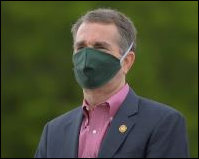by James A. Bacon
Virginia ranks near the bottom of the U.S. states and territories in tests per million population. Its rate of testing is on a par with Guam’s. So reports the Washington Post today (finally getting around to noticing the exact same point that contributor James Sherlock made a week ago on this blog).
The article quotes House Minority Leader Todd Gilbert, R-Shenandoah, as criticizing Governor Ralph Northam for a supposed failure to ramp up testing.
“At first Governor Northam blamed the Trump administration for not getting Virginia the resources needed to conduct tests. Then we learned that Virginia has testing capacity sitting idle,” Gilbert said. “The Governor then said we lacked the swabs and other testing materials. Yet other states have managed to obtain these resources. Something is fundamentally different — and possibly wrong — with the way Virginia’s testing is being handled. Virginians deserve answers, and they deserve them now.”
The criticism may be valid as long as you accept the assumption, which Northam obviously does, that more widespread testing is going to tell us something that we don’t already know. If there’s a scientific “consensus” about COVID-19 among experts around the world, it’s that more testing is better. What bothers me is that no one in Virginia has effectively explained why more testing is better.
As the WaPo article observes, “despite the testing lags, Virginia’s per capital covid-19 deaths have been far lower than in Maryland.”
How about that. Maybe testing is over-rated.
Northam has tied a rollback of emergency COVID-19 shutdown measures in Virginia to a significant expansion of testing, and he has appointed a task force to figure out how to ramp up from 4,000 tests daily to 10,000. Yesterday, he attended a function — duly wearing a face mask — highlighting the testing of low-income African-Americans in Richmond.
“In order for us to eventually start easing the [business and social] restrictions, we’ve got to be able to test,” Gov. Ralph Northam (D) said at the testing site. “It is very important to let all Virginians — whatever neighborhood they come from, or whatever walk of life — know that we’re here for them,” Northam continued. “We want to take care of them.”
Virginians have yet to hear how Northam picked that figure of 10,000 tests. It’s a nice round number that sounds like it would play well in the media. But what is the scientific justification? What will the testing regime look like? And how will it help us to better combat the epidemic?
The testing initiative that Northam visited yesterday had a strong social-justice component. As the WaPo put it:
With dozens of medical personnel and volunteers decked out in masks, face shields and bright gowns, the site offered a possible way out of the pandemic — for a city where 13 out of 14 coronavirus fatalities have been African Americans, and for a state where testing has lagged most of the nation.
The article alluded to the possibility that African-Americans have been under-tested, quoting an individual by the name of Lawrence Washington, who noted fears of a “Tuskegee”-type trap. Washington was alluding, of course, to the infamous Tuskegee institute study of syphilis in 600 black men without their informed consent. And the article quoted Richmond Mayor Levar Stoney as urging residents not to be deterred by “myths” about testing.
What’s the point of this particular testing initiative — other than accomplishing the political aim of demonstrating his sensitivity about race, as Northam habitually has done since his blackface scandal?
I could see the point when hospitals were prioritizing patients with COVID-19-like symptoms for testing. The idea was to isolate them from other patients and ensure they received appropriate treatment. I could see the point when hospitals were prioritizing health care practitioners interacting with COVID-19 patients to ensure that they were not infected and unintentionally spreading the disease. I could see the point when nursing homes were testing as a means to detect a threat to their highly vulnerable patient populations. I could see the point when the Department of Corrections was testing to see if anyone in its cloistered prison populations had the disease so they could be quarantined. In each of those cases, testing had a tangible, identified purpose.
Well, if affluent white people can afford to go to Patient First and get their noses swabbed and find out if they have the virus, social justice advocates might say, it’s only fair that poor black people can get tested, too.
That may or may not be a valid point — but it misses the larger picture. What I want to know is how this particular testing event contributes to the larger understanding of the COVID-19 epidemic. And what does it tell us about the purpose of the larger testing regime that Northam has in mind?
Here’s what might make sense but we have not heard: The Virginia Department of Health, Virginia hospitals and allied organizations are undertaking a testing regime that encompasses all geographic regions in Virginia, all racial and ethnic groups, and all age categories. And they will do so in large enough numbers and in a randomized manner that will enable them to draw statistically valid conclusions about the prevalence of the disease — its intensity, where it is progressing, where it is receding — in order to inform decisions on how to roll back emergency shutdown measures.
But that’s not what we’ve heard. A lot of scattershot testing, even at the 10,000-a-day level, by urgent care centers, physicians offices, hospitals, nursing homes, employers, public health authorities, and social-justice activist groups — all using different protocols and focusing on their own particular priorities — may not give us the kind of data we need to extract us from our collective misery.



